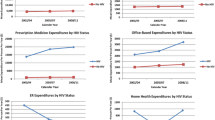Abstract.
The World Health Organization reported that in 1996, for the first time in the course of the AIDS epidemic, there had been a marked decrease in deaths among people with AIDS in many industrialized countries due to the administration of advanced drug therapies and the performance of prevention programs. In response to such changes, policy makers can use our strategic decision support system to determine cost-effective prevention programs. We illustrate the model by analyzing the administration of advanced drug therapies combined with different assumptions for the behavior of the population of Vienna. We estimate that the city of Vienna will have to provide at most 5.6 billion Austrian Schillings for drug therapies, additional treatment, and HIV screening during the period from 1996 to 2005, depending on whether or not these more costly drug therapies reduce the additional treatment costs of HIV-infected and AIDS-diseased individuals.
Similar content being viewed by others
Author information
Authors and Affiliations
Additional information
Received: June 12, 2000 / Accepted: August 31, 2001
Rights and permissions
About this article
Cite this article
Rauner, M. Resource allocation for HIV/AIDS control programs: a model-based policy analysis. OR Spectrum 24, 99–124 (2002). https://doi.org/10.1007/s291-002-8202-x
Issue Date:
DOI: https://doi.org/10.1007/s291-002-8202-x




